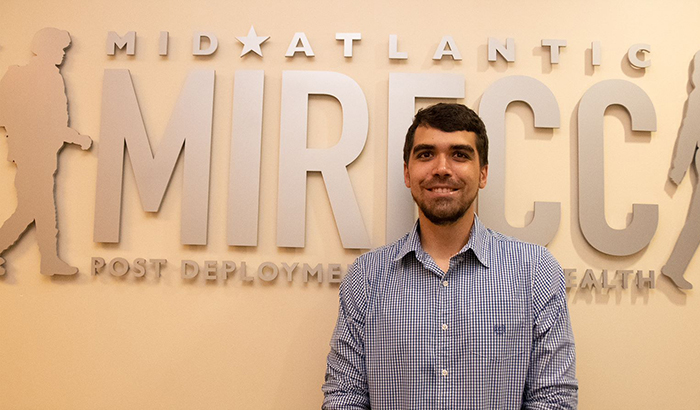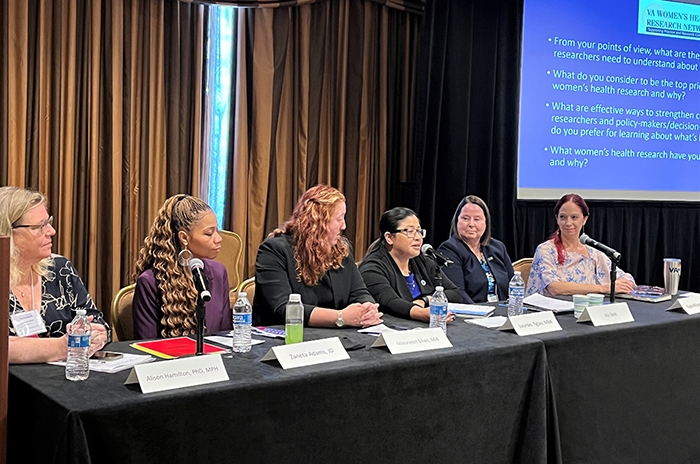Office of Research & Development |
 |
Office of Research & Development |
 |


Dr. Robert Graziano, the lead researcher on the study, received support from the Mid-Atlantic Mental Illness Research, Education, and Clinical Center at the Durham VA.
June 11, 2021
By Mike Richman
VA Research Communications
"When applied to psychopathology, or the study of mental disorders, network theory proposes that mental disorders are caused by the complex interactions of factors called nodes."
Predicting suicide has long been one of the most researched subjects in psychology. One of the key conclusions is that suicide has many risk factors, and that it’s hard to pinpoint how those factors relate to one another.
Dr. Robert Graziano is a postdoctoral fellow in clinical psychology at the Durham VA Health Care System in North Carolina. He led a study on the risk factors among Iraq and Afghanistan Veterans for suicidal ideation, or thoughts of dying by suicide, using an emerging approach in mental health research called network theory. Its main purpose is to illustrate how a series of variables—in this case risk factors for suicide—relate to each other and which ones are the most important, thus addressing a major shortcoming of other methodologies.
Network theory, also referred to as network analysis, is usually carried out with the help of a software often used for statistical computing.
Graziano and his team found suicidal ideation to be strongly related to depression, with small connections to past suicide attempts and anger. Previous suicide attempts were strongly related to the history of childhood trauma and weakly related to illegal drug use and PTSD. “These results offer valuable information for both predicting suicide risk and differentiating targets for interventions lowering suicide risk in Veterans,” the researchers write.
The findings appeared in the Journal of Psychiatric Research in April 2021.

VA Researcher Named One of U.S.’ Top Female Scientists

2023 VA Women's Health Research Conference

Self-harm is underrecognized in Gulf War Veterans

New VA study to determine best drug for Veterans with treatment resistant depression
Graziano’s study isn’t the first one to use network theory to look at suicide. But he believes only one other study—research led by Dr. Jeffrey Simons of the Sioux Falls VA Health Care System in South Dakota—used network theory to examine suicide risk factors in the Veteran population.
Graziano’s work built on Simons’ study by looking at series of additional important risk factors related to suicide risk. Simons’ study included trauma exposure, PTSD symptoms, and depression, but Graziano added past suicide attempts, substance abuse, anger, and sleep quality. Including those additional risk factors allowed Graziano and his team to look at a larger set of potential links related to suicide risk.
Network analysis is based on the factors included in the models, but researchers are often limited by what’s available in their data, Graziano explains. His study had a relatively large sample size of 2,268 Veterans, which has historically been a limitation in studies using network theory. The data were collected via surveys and have been used in many other studies. Without a large sample size, he notes, a researcher can’t include a lot of risk factors and expect to create a stable, accurate network. Simons’ study included 276 Veterans.
Suicide prevention is VA’s top clinical priority. VA’s 2020 National Veteran Suicide Prevention Annual Report notes that in 2018—the most recent year for which data are available—the total number of Veterans who died by suicide increased less than one percent compared to the prior year to an average of 17.6 per day.
Graziano, an Army reservist, spoke to VA Research Currents:
VA Research Currents: What exactly is network theory?
Graziano: When applied to psychopathology, or the study of mental disorders, network theory proposes that mental disorders are caused by the complex interactions of factors called nodes. Think of it like a chain. One node brings about another. That way, nodes directly and indirectly cause other nodes. For example, if someone struggles with depression, maybe that person is often ruminating about things that make them sad. If they are ruminating, maybe it’s hard to fall asleep at night. If they can’t sleep at night, maybe they have trouble concentrating the next day. If they can’t concentrate, maybe they do worse at work, which might cause them to feel like a failure. If they feel like a failure, perhaps they ruminate, which brings us back to where we started. In this way, one node (rumination) caused other nodes (difficulties with sleep, concentration, and feeling like a failure) to occur. This is just an example. We could do this thought exercise with other disorders like PTSD or general anxiety disorder.
Network theory really highlights how disorders aren’t caused by one thing. Network analysis is just the application of this theory. It creates a “network” that illustrates this phenomenon. Network analysis certainly has its limitations and, as is the case with all research, we need lots of studies looking at similar things before we can really be confident about our results. Having said that, network theory is a great way to look at the nuances and complexities of how many different variables relate to one another. In this study, we applied this idea to suicidal ideation, an unfortunately common symptom in our Veteran population.
Why isn’t network theory used more often in research?
The main reason is that it’s simply a novel way of doing things. If you were to do a literature review of network theory being applied to psychological research, the vast majority of studies would have been conducted over the past five years. Having said that, network theory is quickly gaining popularity within the psychology field. I can remember the first time I saw it mentioned at a conference. Now, it seems like conferences always have a fair amount of discussion on network theory.
Were you surprised by the results of your study?
Some of the results are certainly not surprising. We expected depression and prior suicide attempts to be strong predictors of suicidal ideation. The real value of this study rests in being able to see the whole picture at once. For example, PTSD was not directly related to suicidal ideation, but it was related to depression, which again is related to suicidal ideation. Similarly, combat exposure was not directly related to suicidal ideation, but it was related to depression and PTSD. These are important nuances if we want to identify who is most at risk for suicide. Other results were interesting, too. Anger and substance misuse were both related to suicidal ideation.
This isn’t the first study to find any of these results. But network analysis is fantastic because it lets us see all of these results play out at once.
What influenced you to pursue this study?
I came across network theory while writing my dissertation in graduate school at the University of Missouri—St. Louis. The way it broke down such a complex phenomenon, the cause of mental disorders, in such an easily digestible way really resonated with me. More importantly, I also found that it resonated with patients and was crucial in both instilling hope for recovery and defeating self-stigma related to mental health diagnoses.
With regard to this study, I was extremely lucky to have the Mid-Atlantic Mental Illness Research, Education, and Clinical Center (MIRECC) workgroup at the Durham VA share its data and work with me while I was a doctoral intern at the Durham VA. In particular, I am extremely grateful to Dr. Kirsten Dillon, who volunteered to serve as my research mentor that year and Dr. Eric Elbogen, who has been my mentor for a decade. Three other mental health researchers at the Durham VA, Dr. Stefanie LoSavio, Dr. Jean Beckham, and Dr. Frances Aunon, also made integral contributions in coauthoring this study. Together, we got to work on how I could use the knowledge base I already had on network theory to support the mission of the Mid-Atlantic MIRECC. The topic of predicting suicide was a natural conclusion, as it is sadly so prevalent in our Veteran population. Coming from a military family and being a service member myself, this research question remains deeply personal and important to me.
How do you hope these findings will help Veterans at risk for suicide?
This study is intended to help us predict who is most at risk for suicide, which in turn informs treatment. The study speaks to the importance of clinicians getting into the details of their patients’ symptoms to understand their suicide risk. For example, sleep problems may not predict thoughts of suicide and did not in this study. But they meaningfully exacerbate problems with depression.
Depression does predict suicide risk, so we’d want to know that. The same question could be asked with regard to PTSD and combat exposure, as well. Similarly, alcohol misuse may not predict suicidal thoughts on its own. But it does predict anger, which was found in the study to predict suicidal ideation. Clinicians need to understand these relationships and try to conceptualize what the “network” may look like for their patients. Finally, this study also highlights the importance of social support. Strong social support strongly predicted lower depression and subsequently lower suicide risk.
VA Research Currents archives || Sign up for VA Research updates